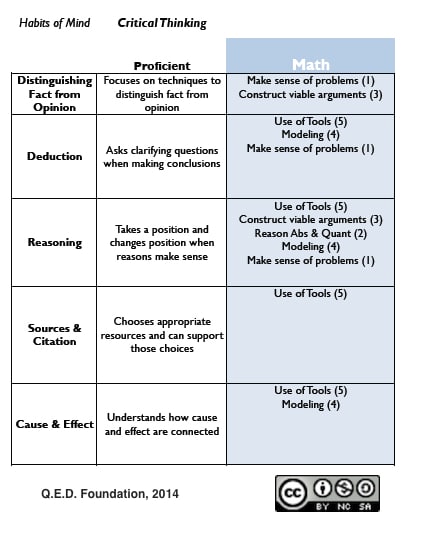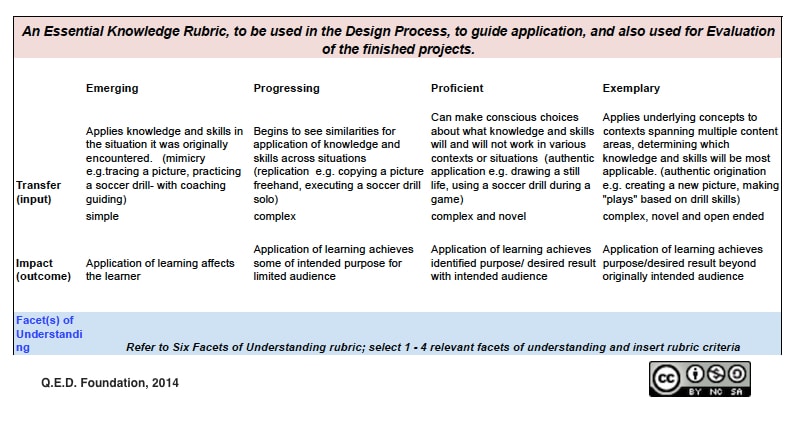A Construction Kit for Personalized Assessment of Competency-Based Learning
CompetencyWorks Blog

This post originally appeared December 15, 2014 at Q.E.D. Foundation.
“What Changes in the Learner Are You Trying to Cause?”
Our perspective at QED is that competency based learning is first and foremost performance based, which means assessments – and assessment literacy – are essential, even more essential than the curriculum. Years ago, (1990, long before it became a rallying cry for Common Core opponents), Grant Wiggins identified assessment as “the Trojan horse” of education restructuring, or the means to “adapt schools to meet the needs of learning.” (Ed Week, 10/10/90)
Citing Ralph Tyler’s Basic Principles of Curriculum and Instruction at a much more recent training (July, 2014, Lambertville, NJ), Wiggins exhorted educators to “honor the Ralph Tyler idea that you don’t design backward from the curriculum, but from the learner being different: what changes in the learner are you trying to cause?”
Backward Design from the Graduation Goal
For Making Community Connections Charter School (MC2), the desired “change in the learner” is identified in its mission to develop graduates who are empowered with the knowledge and skills to use their unique voices effectively and with integrity in co-creating their public global world. This is, in effect, our One Big Competency.
To design a system to bring about that “change” for our learners, we need to break that graduation outcome into the three difference types of goals that need to be addressed: meaning making goals, transfer goals, and acquisition of knowledge and skills goals. (Wiggins/McTighe; Schooling By Design)
We want our learners to make meaning around the ways they do shape their world, for better or for worse, based on the decisions they make. We want them ready to transfer the MC2 Habits – 17 original ones, based on Antioch University of New England’s Critical Skills, along with an eighteenth, Global Leadership, courtesy of Asia Society.
Some of the habits are “habits of mind” (e.g. Critical Thinking) while others are “habits of being” (e.g.Self Direction). While that may seem like a lot of habits to keep track of, we believe these habits represent core dispositions our graduates need for living lives of learning, meaning making, and public action.
Mapping Each Discipline to the Graduation Outcome
Our next step in “planning backward” has been to identify how each discipline contributes to those goals. We believe that every discipline at its core is a set of habits of mind, a lens through which that disciplinarian approaches and views their world. So we’re looking at the ways in which the habits of mind, the dispositions, create views of the world through which we act to shape our world.
So when we look at standards – Common Core standards, NextGen Science Standards, and standards developed by various national organizations – in addition to the concepts, content and skills, we are looking for the discipline practices and mapping those to our habits.

For instance, the Common Core mathematics standards delineate eight mathematical practices, which we’ve cross-walked onto our existing habits of mind. (example below) We’re in the process of cross walking the ELA anchor standards and the NextGen scientific and engineering practices processes, which will be followed by similar cross-walks and analyses of other discipline standards from national organizations such as National Council for Social Studies, American Council on the Teaching of Foreign Languages, and International Technology and Engineering Educators Association).
In order to engage in these practices (mathematical or otherwise), knowledge and skills are important and necessary. (As the Next Gen Science standards stress, “engaging in scientific inquiry requires coordination both of knowledge and skill simultaneously.”(p. 41, A Framework for K-12 Science Education) In a world of “permanent white water,” content and skills are the “raw” material that operationalize learners’ habits of mind and being.
Foreground and Background
QED’s Coaching Director Elizabeth Cardine frames the relationship between habits/dispositions and content/skills this way: “I think of the content and the habits as foreground and background, and there’s an interplay. There are times when the content and skills are the foreground and the habits of mind and dispositions or 8 mathematical practices and science processes are the background and other times when the habits of mind and dispositions are the foreground and the content and skills of the particular subject area or discipline area are the background.”
MC2 uses a five-stage process for competency-based learning: design, construct, apply, document, and defend. My hypothesis is that whether content and skills are foreground and habits/dispositions background or vice versa is based on where we are in the learning/instructional design cycle. When we are first designing learning, we identify an experience that draws us into the learning through reflection and inquiry – habits/dispositions. (This catalyzing experience could be constructed by the teacher, or identified by the learner.) During the construct stage, content and skills are more foreground, with deliberate practice (a combination – or “alloy” – of habits and dispositions) taking center stage. As learners move into the apply stage, the habits of mind and dispositions move into the foreground, with the content and skills serving as materials.
In a competency based learning system, where performance is key, we need to be clear about how we incrementally make the work harder. Here again, Wiggins provides essential insight: “It’s not about the curriculum. It’s about the assessments. We have to make sure the assessments get more rigorous. We have to work more on the assessments rather than the inputs, so we can chart gains against the assessment system.”
A Proposal for a CBL Assessment Construction Kit
Thus, the means by which we design assessments that are both academically rigorous AND developmentally appropriate is essential to personalizing learning in a competency based learning system.
In a highly personalized competency-based learning system, we believe our task is to define a common set of performance standards that can be applied across uncommon assessment ofuncommon learning. What follows is our draft of the foundational components for an assessment system intended to hold powerful standards for all learners while being responsive and flexible enough to support uncommon assessments of uncommon learning.
There are three “building blocks” that comprise the common set of performance standards from which content area assessments will be “constructed”: the Essential Knowledge Rubric, mapping the conceptual development progression from Novice to Expert; the Habits of Mind and Being, dispositions that comprise the behaviors and attitudes necessary for success; and Learning Progressions, specific knowledge and skills that benchmark progress toward proficiency for each content area. A more detailed explanation of each of these three components follows.
Essential Knowledge Rubric comprised of the following indicators:
- Transfer
- Impact
Understanding: 1 to 4 relevant facets of understanding are selected from the Six Facets of Understanding rubric (Wiggins and McTighe, The Understanding By Design Guide to Advanced Concepts in Creating and Reviewing Units).
Habits of Mind and Being
- Applicable MC2 Habits of Mind indicators are selected during the application (summative assessment) design process
- At this point we posit that there are “alloys” or “Über Habits,” comprised of combining our foundational habits into characteristics or dispositions that lead to success (e.g. resilience, innovation, and, importantly for the development of Essential Knowledge proficiency, Deliberate Practice) but we haven’t yet determined how to best represent these. For now, you will see a line for “Deliberate Practice” holding our thoughts about the role of this “Über Habit”. [Note: We also note that such habits and “Über Habits” are not observable solely through a final product, but must be observed, assessed, monitored along the way, so are not in themselves a part of a summative assessment.]

Learning Progressions –
- We refer here to the research-based progressions of conceptual understanding through the developmental corridor from Novice to Expert. Learner progress is mapped onto the discipline learning progression, recording both the proficiency range of performance and the mode, or most consistent level of proficiency.
- We have found some learning progressions, particularly for the Common Core standards, but need to continue our research and may need to develop some drafts of our own, in collaboration with other experienced educators, for those areas for which such research is scarce (for instance, physical fitness).
- In the meantime, there are two indicator rows (Knowledge and Skills) that are intended as placeholders pending identification of relevant learning progressions.

While the above initially sounds complicated, we have largely completed the process of building into our learning management system the templates and menus that walk our educators and learners through the assessment “construction” process, helping “shape the path” as they make the shift to a performance based assessment system.
Kim Carter is a Students at the Center Distinguished Fellow and Executive Director of the Q.E.D. Foundation, an organization of adults and youth working together to create and sustain student-centered learning communities.